[Matt Roth is Deputy Editor of Streetsblog San Francisco, and a rabid bicycle enthusiast working towards the realization of a world full of bike-friendly cities. This post is part of the Metropol Blog Series.]
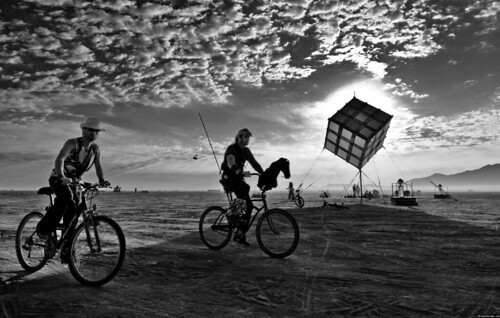
Anyone who has lived in a relatively flat and congested city can tell you the best way to get around is on a bicycle. The Chinese, the Dutch and the Danish know it, and increasingly Americans are coming to understand there are few modes of urban mobility as convenient and healthy as putting the fun between your legs and pedaling where you want, when you want.
As the legions of urban bicycle riders grow, city planners have begun to take note and have carved away precious space from several generations of begrudging motorists who have long believed streets were their sole domain. Politicians now boast of how many bicycle lanes they have added, sometimes buffered from traffic, sometimes painted green, red or blue. Some cities have instituted bicycle sharing systems, where a fleet of public bicycles are maintained for use by anyone who signs up and pays a small fee. The newest bicycle trend to gain popularity in cities around the world is the ciclovía, a car-free event where roads are opened to bicycles, skaters and pedestrians for the day to enjoy streets as public space for recreating and socializing.
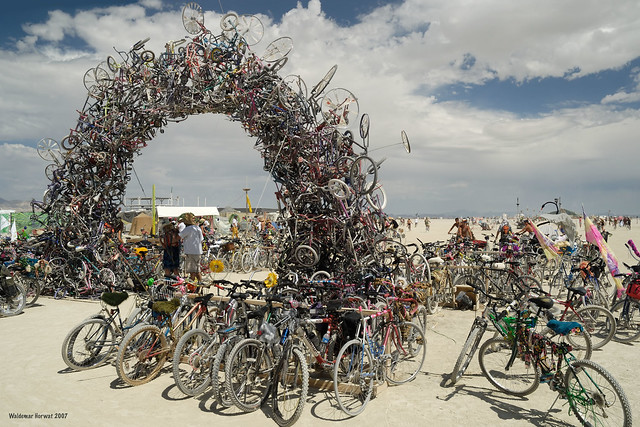
Black Rock City, more than any other urban area, has been given over completely to bicycles, making it unquestionably the highest bikes-per-capita metropolis anywhere on the planet. The playa is the perfect place to ride, flat as a board and expansive. The prohibition on driving anything but art cars beyond the Esplanade makes Burning Man an enormous week-long ciclovía, and makes bicycles of the ultimate utility during the event.

As with most everything else on the playa, a simple bicycle, with one wheel in front of the other, would scarcely begin to capture the experience of participating in Burning Man, nor would it be very cool. Though the dynamics of bicycle engineering haven’t changed much in a hundred years, Black Rock City has spawned a menagerie of innovation, still pedal-powered, but only vaguely resembling a “bicycle.” There are giraffes and fishes, camels and glowing eyeballs, carriages adorned with mastodon bones, tall bikes five frames high, and an number of kinetic sculptures belching plumes of fire and smoke from their steel innards. Whimsy trumps utility and getting to the destination is less important than preening like a peacock along the way (a twelve-foot tall fire-spewing peacock, of course).

While you might go to your first burn with a beach cruiser or a crusty old mountain bike you don’t mind destroying in the gypsum, after you see all the fabulous creations drifting slowly by, it’s unlikely you will return the next time with a prefab bike. At a minimum you’ll wrap it in EL wire and throw on some Hokey Spokes, but there’s a good chance you’ll do more. After all, why would you settle for a frame building assembly line in Taipei when you could weld it yourself?
Scott Cocking, who camps with the Department of Spontaneous Combustion, went to his virgin burn in 2000 with an old mountain bike. On playa, he was enthralled with the kinetic sculptures made for Burning Man, fantastical heaving machines with little or no application beyond the Black Rock lake bed.
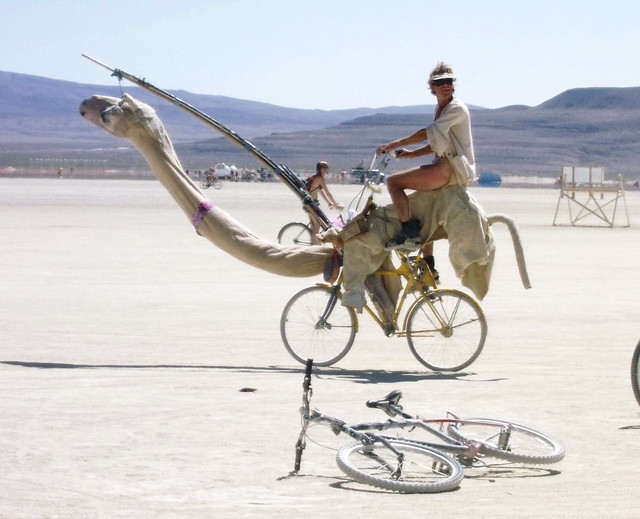
Cocking had never operated a welder, nor did he understand the mechanics of bicycles, but he went home and studied anything he could find. A friend of his who later helped form Spontaneous Combustion told him to get a few sawhorses and start welding metal together. He could always cut them apart if it didn’t work as expected.
“You eventually get it right. You get this thing that is craptastic,” said Cocking. “The more people that build silly stupid bikes and bring them to Burning Man, the better off we are.”
Cocking and fellow tinkerers have stumbled upon a model that is contagious. When people see the bikes, they want to ride them and they soon ask how to build them. Off playa, they trade ideas and build photos, a classic crowd sourcing scenario. Someone in San Diego uses plastic storm gutters to fabricate wheels, puts instructions online and soon someone in Philadelphia has improved the design and shared the experience so someone else in Oakland can make it even better.
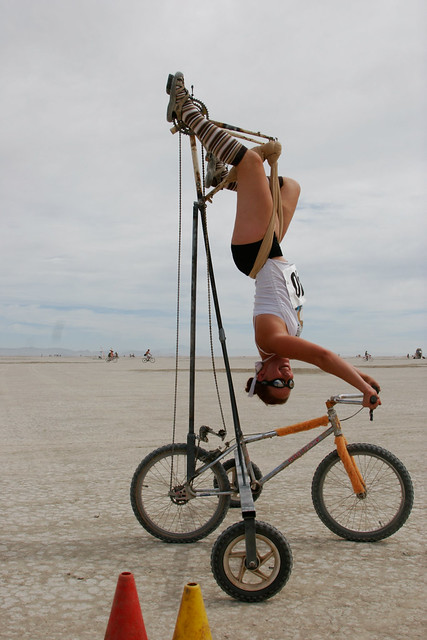
Whether or not the experience and skills gained for machines designed to operate on the flat ground of the playa could ever get traction in our off-playa urban environs is another question. Black Rock City inspires intense creativity and Burners often spend months building the pedal machines they will ride for seven days, offering the spectacle to the community, but then they put them away for another year.
While the DIY bike building culture is alive and well with outlaw bicycle clubs like Black Label and C.H.U.N.K 666 partying and jousting tall bikes on the streets of New York City, Portland, OR, or Austin, TX, the majority of cyclists fall back to utility and ride something built in a big factory somewhere far away.
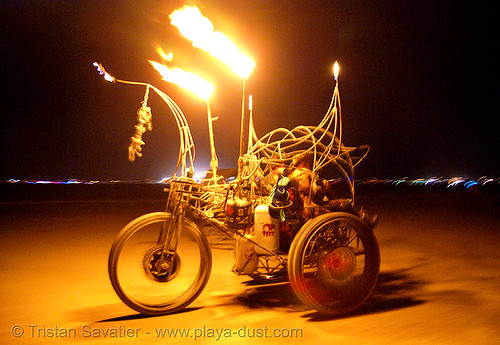
The real challenge will be transforming our cities to allow for Burning Man bicycles to come off playa and be used all year round. One wonders just how far the spirit of creativity and innovation would take human-powered transportation in our home cities if more space were turned over to vehicles inspired by our experience in the desert?
The triumph will come, in my opinion, when we give over whole streets to pedal powered machines, not these meager 6-foot slivers at the fringes. Then you’d be just as likely to see a one-ton Berzerker rolling through The Mission, the East Village, or West Hollywood as you would a Cannondale.
Of course, we’d still have to do something about the fire code to allow thirty-foot flame bursts from the fire cannons!

more than anywhere? really?
I have seen Center Camp look like this in the past.
http://www.huffingtonpost.com/huff-wires/20080707/china-bicycle-kingdom/images/a84bbc7a-cb87-43bc-a743-823a323529c9.jpg
Report comment
Yay! What a fun post about one of my favorite aspects of Black Rock City! we’re trying to bring the spirit of cycling in BRC home–each first Friday in Ventura a bunch of us (some Burners, some not) ride around town to art galleries dressed for a theme.
Report comment
matt captures one of the most impressive aspects of this amazing community building experiments in the desert. makes us proud to call him a shadyvillain.
Shadyvil, this year back at home at 845 & Detroit, complete with bike parking.
Report comment
Matt, thanks for a nice write up! This year at Burning Man: Kinetic Cab Co, at 9:00 & Esplanade will have tons, literally, of pedal powered treats…. and portions of the DSC will be at 8:00 & E/D with loads of bikes / trikes. Most of the other DSC members are building the temple, but will have their machines out and about. Come by, find me and ride whatever you want! Our amazing bike building friends from Philly (PEX) will ALSO be at 8:00 & A with some other fun machines… and more builders near by.
I have a cold beer with your name on it!
Ride on – Scotty C.
Report comment
It was extremely interesting for me to read that blog. Thanx for it. I like such topics and anything that is connected to them. I would like to read a bit more soon. BTW, pretty good design this site has, but how about changing it once in a few months?
Whitny Swift
escortgirls
Report comment
hello
can anyone help – trying to track down Ben who is a sculptor – made some excellent bikes out of recycled materials and was at Burning Man this year – lives in Orange County – a long shot i know but worth a try with the Burning Man magic!
Thank you
Venetia
Report comment
Remarkable! Its really remarkable paragraph, I have got much clear idea regarding from this post.
Report comment
Comments are closed.